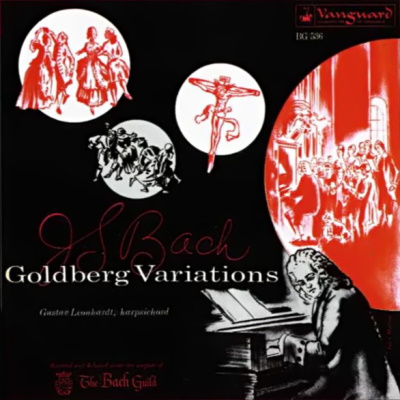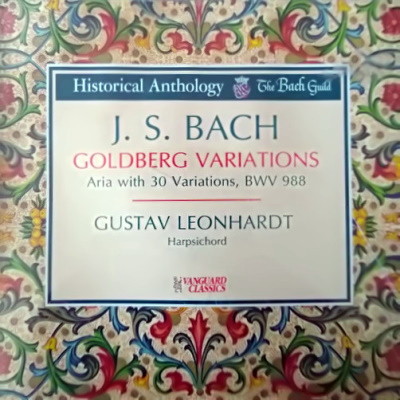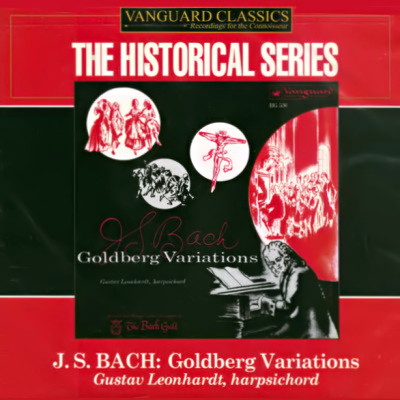 |
|
1 LP -
BG-536 - (p) 1954
|
 |
| 1 CD -
OVC 2004 - (p) & (c) 1992 |
 |
| 1 CD -
ATM-CD-1281 - (p) & (c) 2005 |
|
GOLDBERG
VARIATIONS
|
|
|
|
|
|
|
|
| Johann Sebastian
BACH (1685-1750) |
GOLDBERG
VARIATIONS - Air with Thirty Variations,
BWV 988
|
|
|
|
|
- Air
(Sarabande) and Variations 1-15
|
|
27' 15" |
A
|
|
-
Variations 16-30 and Aria da capo |
|
27' 05" |
B
|
|
|
|
|
|
Gustav LEONHARDT,
Harpsichord (Ammer, Eisenberg, Germany)
|
|
|
|
|
|
Luogo
e data di registrazione |
|
Konzerthaus, Vienna
(Austria) - giugno 1953 |
|
|
Registrazione: live
/ studio |
|
studio |
|
|
Producer |
|
Seymour Solomon
|
|
|
Engineer
|
|
Otto Panytsch
|
|
|
Prima Edizione LP |
|
Vanguard - The Bach
Guild | BG-536 | 1 LP - durata 54'
20" | (p) 1954
|
|
|
Edizione CD |
|
Omega Record | OVC
2004 | 1 CD - durata 54' 19" | (p)
& (c) 1992 | ADD
Artemis Classics | ATM-CD-1281 | 1
CD - durata 54' 19" | (p) &
(c) 2005 | ADD
|
|
|
Cover Art
|
|
- |
|
|
Note |
|
Billboard, 18
september 1954
|
|
|
|
|
The Aria
with Thirty Variations
or Goldberg Variations,
by Johann Sebastian Bach
(1685-1750), is one of the
great masterpieces of the
composer's last years.
Published by Bach in 1742,
iy constitutes the fourth
part of his Clavierübung.
In it Bach summed up
everything done in the
variation from before him,
brought the form to a new
level of breadth and
grandeur, and carried on
harmonic explorations that
foreshadowed the future
development of music. Two
extremes meet in it. On the
one hand, it contains
passage after passage of the
most airy, light and
frolicsome music, in the
spirit of an
"entertainment." On the
other hand, it is one of
Bach's profoundly "learned"
works, in which he set
himself and solved intricate
problems of polyphonic
writing. It embodies an
architecture similar to that
of the Canonic
Variations and Art
of Fugue, but clothed
in a galant raiment
of ornament and arabesque
reminiscent of the French
and English suites.
The set of variations was
written for one of Bach's
former pupils, Johann
Theophilus Goldberg, to play
for his patron, the Baron
von Kayserling, on the
nights when the Baron
suffered from sleeplessness
and "melancholy thoughts."
Kayserling never wearied of
hearing them, and in his
gratitude gave Bach a
snuffbox containing a
hundred Louis d'or.
But in his work Bach spoke
also to the learned
musicians of his time,
offering them an
encyclopedic set of lessons
in baroque counterpoint. He
furthermore brought together
every style and mood from
witty "galanteries" and
stately dances to the most
poignant sadness and
openhearted paesant humor,
and gave the whole a
structural unity that only
his great musical intellect
could conceive and execute.
All the thirty variations
are based on the harmony of
the opening aria, but not in
all the variations are these
harmonic steps clearly
heard. In some, such as the
heartrending twentyfifth,
they are contained within a
pregression which so
envelops them that the music
seems to come from a
different harmonic world.
Bach unifies the work by
making each third variation
a canon and each successive
canon is on a rising
interval, the series
starting with a canon in
unison, the next being a
canon on the second, the
next a canon on the interval
of a third and so on. The
second variation after each
canon is a duet.
The aria on which Bach
builds this musical edifice
is a sarabande, which he had
written some ten years
before in the clavier
notebook of his wife, anna
Magdalena. It is in two
parts, and the subsequent
variations are also each in
two parts, with the second
part of each embarking on
the more adventurous
harmonic paths.
The mood which Bach sets at
first is one of airy
"galanterie." After the
sarabande, we hear (1) a
duet with wide leaps and
arpeggios, then (2) a trio
in pastoral mood with a
lively bass, (3) the canon
in the unison, (4) a lively
study in triple time of
polyphony with inversions,
and (5) as a climax of this
mood, a joyous outburst in a
duet employing crossing
hands. Then we return to the
realm of the dance with (7)
a whimsical piece in the
rhythm of a gigue or
Venetian forlane.
Next (8) is another
brilliant duet, with hands
crossing, after which comes
(9) the canon in the third
with the answer entering
below the subject, and (10)
a fughetta.
The gravity that had been
introduced by the sixth
variation is taken up now
and deepened with (11) a
charming and tender
dialogue, after which comes
(12) the canon in the
fourth, in which the answer
is an inversion of the
subject. In the beauty,
clarity and strenght of this
canon we begin to perceive
the rock-like structure
which Bach is building
within what has seemed up to
now to be largely a
frolicsome mood. With the
next variation (13) we are
drawn still further into the
vein of tender sadness, the
style being close kin to
that of the slow movement of
the Italian Concerto.
A brilliant display of high
spirits follows (14), after
which the poignant feeling
returns with (15) the canon
in the fifth, in which the
answer again is an inversion
of the subject. This is also
the first variation in a
minor key, and it marks a
new stage in the emotional
development of the music.
The sadness which we have
now reached will become even
deeper, although alternating
with joyous episodes.
Side two of the recording
opens with a variation (16)
in the spirit of a French
overture, with a stately
processional followed by a
faster section, after which
there is (17) a brilliant
duet exploiting fully the
double keyboard, and (18) a
canon in the sixth, with the
rhythm of a march, and the
two canonic parts
interweaving over a
harmonically rich bass. A
short, sprightly variation
in trio texture (19) is
followed by one of the most
vivacious and rhythmically
complex duets (20), and then
(21) the canon in the
seventh, which is also the
second of the variations in
minor and is full of
sweetness and pathos. A
study in massive, four-part
polyphony (22) now appears,
followed by what Tovey
characterizes as a "madcap
frolic" (23), and then (24)
by the canon in the octave,
which has the rhythm of a siciliana.
This prepares the ground for
(25) the third of the
variations in minor, and the
emotional climax of the
entire work. The face of
tragedy appears, with a
long, anguished lament,
moving chromatically, as in
the Cricifixus of
the Mass in B minor.
From this point on all is
high spirits and brilliant
virtuosity. We have (26) a
variation in sarabande
rhythm under a running
figuration, followed by (27)
a canon in the ninth which,
unlike the previous canons,
has no non-canonic bass. The
brilliant display music
which its virtuoso demands
now (28) becomes even more
glittering, and the
following variation (29)
carries the bravura display
of human powers still
further. And just as the
poignant outpouring of
feeling of the twenty-fifth
variation was the climax of
the sad variations, so now
(30) the climax of joy is
reached in the earthy
folk-like spirit of the
final variation.
This closing variation is a
Quodlibet, which in
its vocal form had been a
favorite amusement of the
Bach family at its annual
gatherings. Forkel's
description is worth
repeating. "The first thing
they did was to sing a
chorale. From this pious
commencement they proceeded
to drolleries which often
made a very great contrast
with it. For now they sang
popular songs, the content
of which were partly comic
and partly naughty, all
together and extempore, but
in such a manner that the
several parts thus
extemporized made a kind of
harmony together, the words,
however, in every part being
different. They called this
kind of harmony a Quodlibet,
and not only laughed
heartily at it themselves,
but excited an equally
hearty and irresistible
laughter in everybody that
heard them." Bach employs
the melodies of two popular
songs in this Quodlibet,
the words of which begin
"Ich bin so lang nicht bei
dir gewest" ("I long have
been away from thee"), and
"Kraut and Rüben haben mich
vertrieben" ("Cabbages and
turnips have driven me
away").
The curtain which had risen
to reveal this teeming world
of joy and suffering now
closes upon it. The grave
and tender sarabande, which
had undergone such
remarkable transformations,
now returns, peaceful and
unruffled, to bid the whole
world, like the Baron von
Kayserling, good-night.
Notes
by S. W. Bennett
About the
Performance
Gustav M.
Leonhardt, born in 1928 in
Holland, has entered the
select circle of brilliant
instrumentalists who are also
ground-breaking scholars of
Renaissance and Baroque music.
In his student years in
Holland, Switzerland and
Austria he won the highest
honors both for musicology and
performance on the harpsichord
and organ. He is one of the
achnowledged European masters
of the authentic ornaments and
improvisatory style of Baroque
music. In the spirit of the
old musician-artisans, he is
also an expert on the
construction and design of the
harpsichord and Baroque organ.
Since 1952 he has been
professor of harpsichord and
musicology at the Academy of
Music in Vienna, dividing his
time between Vienna and the
Conservatory at Amsterdam,
where he teaches as well.
This recording of the Goldberg
Variations continues the
series of recordings of
Baroque harpsichord and organ
music being made by Mr.
Leonhardt, who is an exclusive
Vanguard-Bach Guild recording
artist. His recording of
Bach's Art of Fugue
(BG 532/3) has already been
established in American
musical life as a classic
reading of this great work,
confirming the praise accorded
by European critics and
audiences following Mr.
Leonhardt's recitals in
London, Vienna and Amsterdam.
This reading of the Goldberg
Variations will likewise
stand as a permanent testament
to the finest Bach scholarship
and interpretative insight of
our time.
For this recording Mr.
Leonhardt has used an Ammer
harpsichord made in Eisenberg,
Germany.
|
  |
|
|